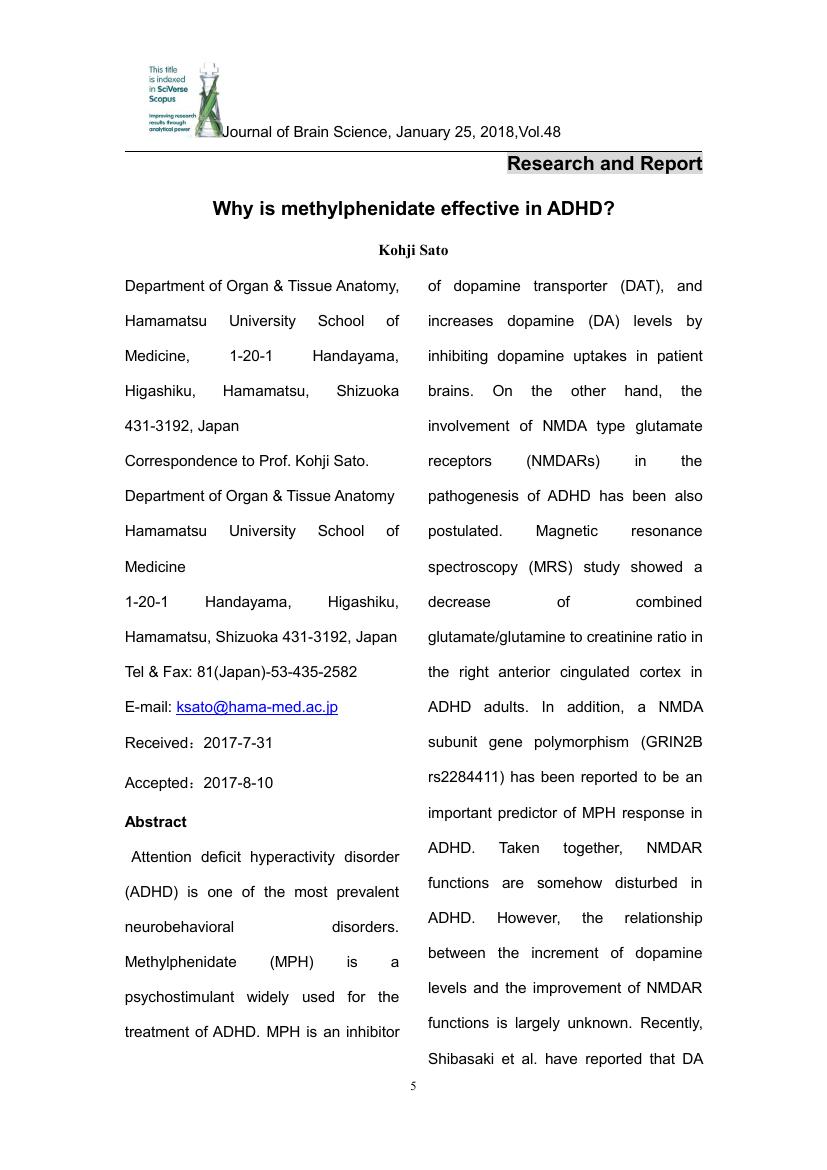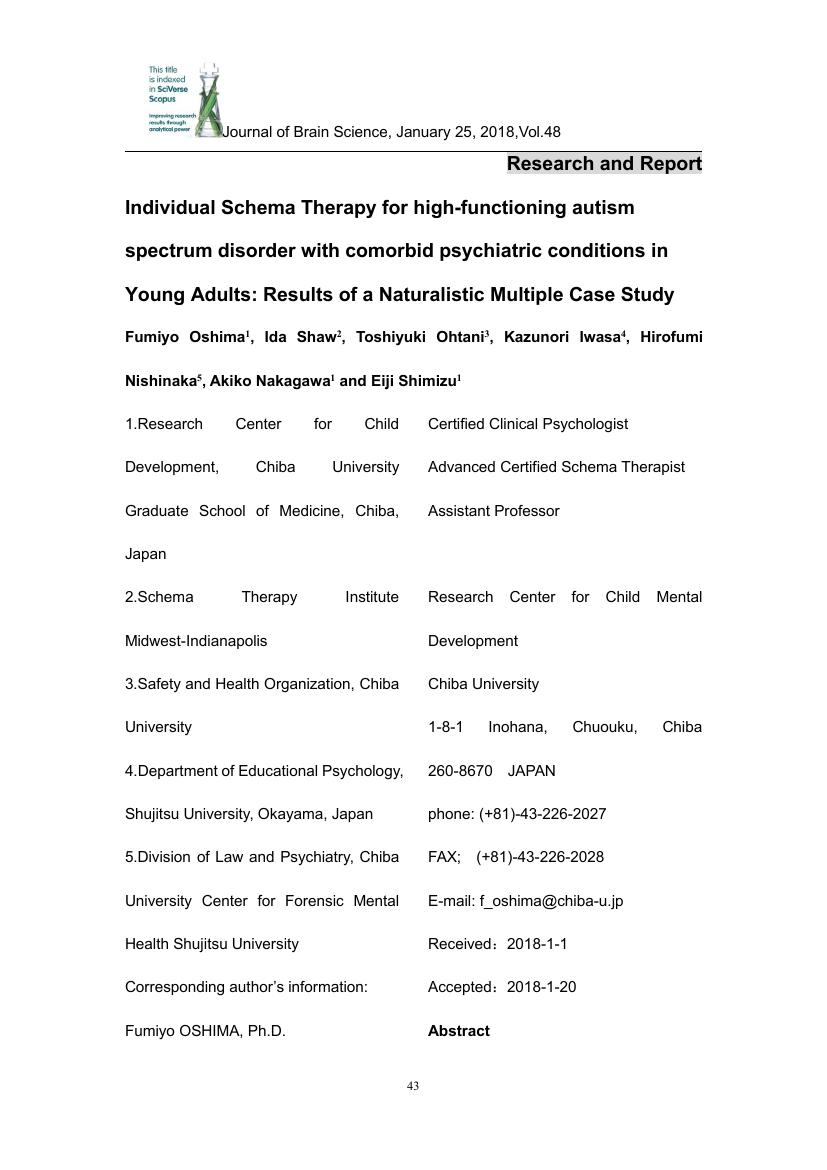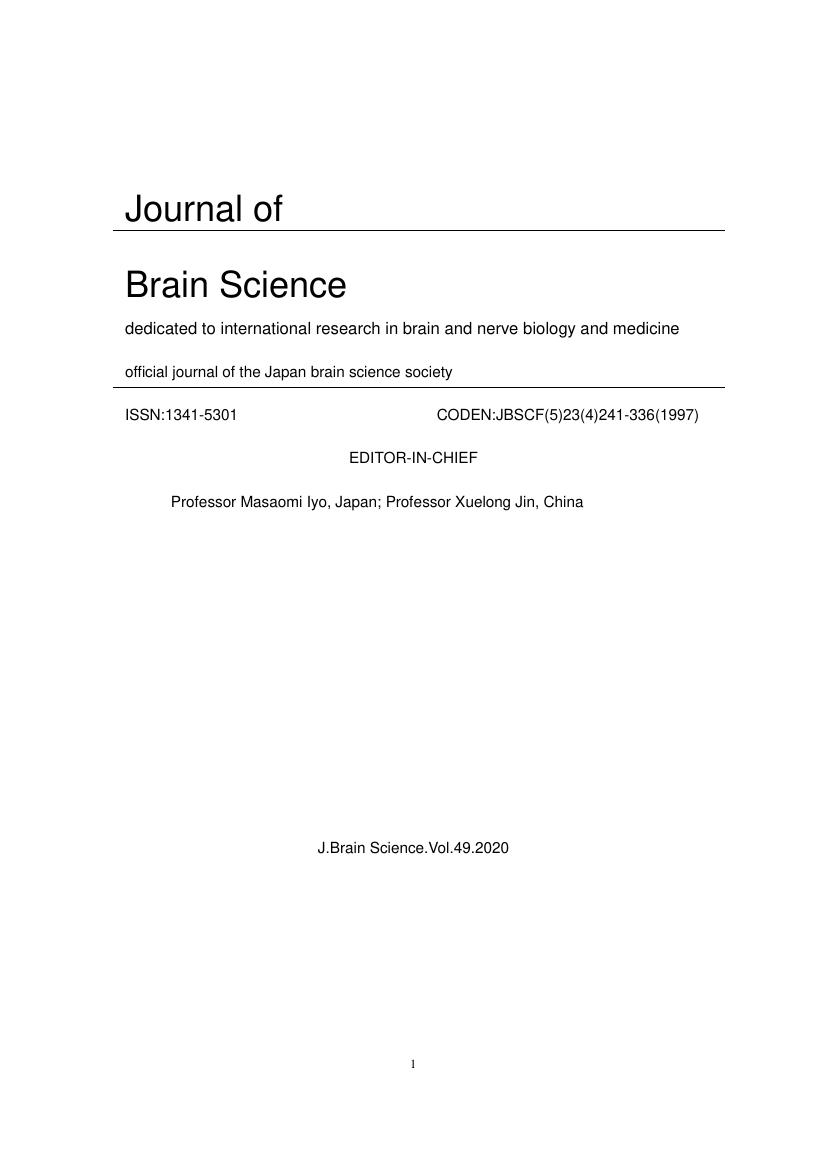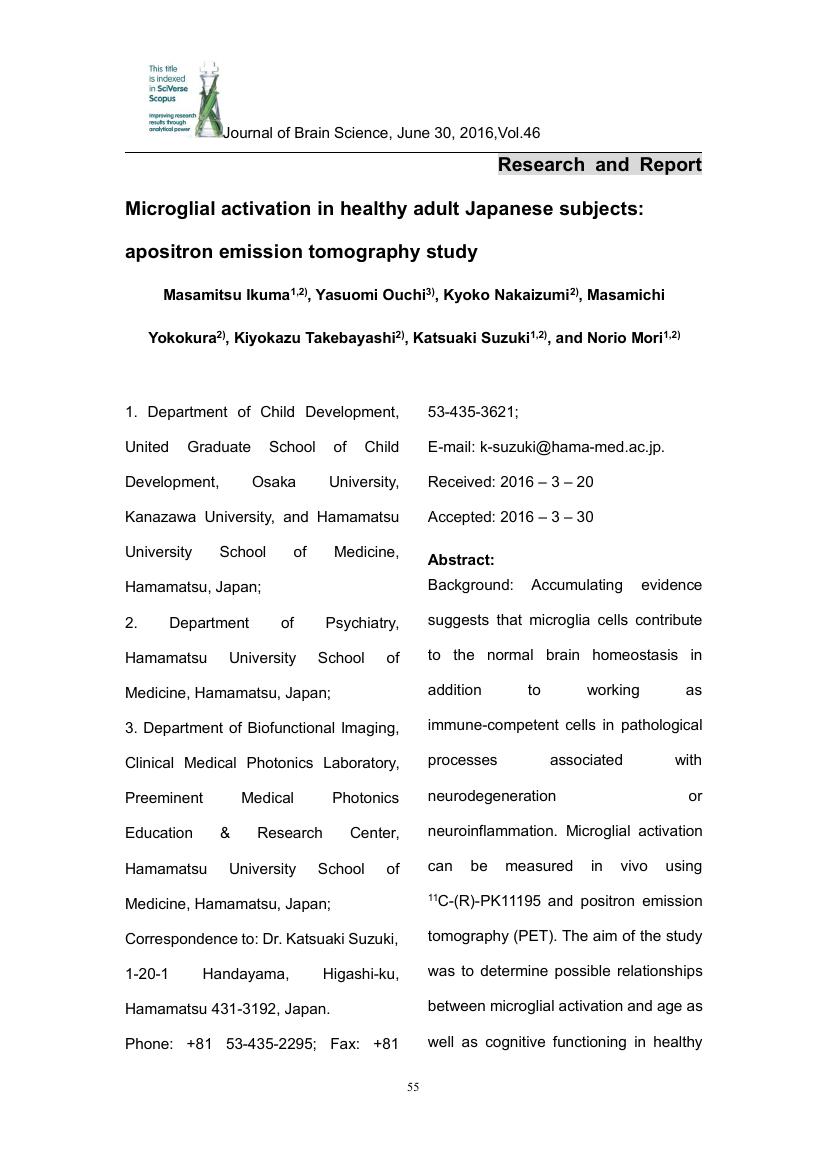- 著者
- HiuKei Li Manabu Oi Keiko Gondo Tomoko Matsui
- 出版者
- Japan Brain Science society
- 雑誌
- 脳科学誌 (ISSN:13415301)
- 巻号頁・発行日
- vol.47, pp.21-49, 2017 (Released:2017-11-01)
- 参考文献数
- 35
2 0 0 0 OA Why is methylphenidate effective in ADHD?
- 著者
- Kohji Sato
- 出版者
- Japan Brain Science society
- 雑誌
- 脳科学誌 (ISSN:13415301)
- 巻号頁・発行日
- vol.48, pp.5-13, 2018 (Released:2018-04-16)
- 参考文献数
- 29
- 著者
- Toko Mori Toshisaburo Nagai Taiichi Katayama Masayuki Endo Kazutomo Ohashi
- 出版者
- Japan Brain Science society
- 雑誌
- 脳科学誌 (ISSN:13415301)
- 巻号頁・発行日
- vol.50, pp.101-135, 2021 (Released:2022-01-18)
- 参考文献数
- 42
- 著者
- KOHJI SATO
- 出版者
- Japan Brain Science society
- 雑誌
- 脳科学誌 (ISSN:13415301)
- 巻号頁・発行日
- vol.50, pp.136-147, 2021 (Released:2022-01-18)
- 参考文献数
- 16
1 0 0 0 OA Investigation of the reliability and validity of the Japanese Deliberate Self-Harm Inventory
- 著者
- Taiko Ohira Toshio Munesue Manabu Oi Kunitake Suzuki Daisuke Saito
- 出版者
- Japan Brain Science society
- 雑誌
- 脳科学誌 (ISSN:13415301)
- 巻号頁・発行日
- vol.48, pp.14-42, 2018 (Released:2018-04-16)
- 参考文献数
- 23
- 著者
- Fumiyo Oshima Ida Shaw Toshiyuki Ohtani Kazunori Iwasa Hirofumi Nishinaka Akiko Nakagawa and Eiji Shimizu
- 出版者
- Japan Brain Science society
- 雑誌
- 脳科学誌 (ISSN:13415301)
- 巻号頁・発行日
- vol.48, pp.43-69, 2018 (Released:2018-04-16)
- 参考文献数
- 31
1 0 0 0 OA Specific components of child gestures at 14 months are associated with preschoolers’ language skills
- 著者
- Yuko Ibara Tomoko Nishimura Ryuji Nakahara Toshiki Iwabuchi Taeko Harada Akemi Okumura Chikako Nakayasu Nori Takei Kenji J. Tsuchiya
- 出版者
- Japan Brain Science society
- 雑誌
- 脳科学誌 (ISSN:13415301)
- 巻号頁・発行日
- vol.49, pp.5-31, 2020 (Released:2020-12-01)
- 参考文献数
- 41
- 著者
- Yoko Sagawa Tomoko Nishimura Yoko Nomura Toshiki Iwabuchi Taeko Harada Akemi Okumura Chikako Nakayasu Nagahide Takahashi Nori Takei Kenji J. Tsuchiya
- 出版者
- Japan Brain Science society
- 雑誌
- 脳科学誌 (ISSN:13415301)
- 巻号頁・発行日
- vol.49, pp.32-62, 2020 (Released:2020-12-01)
- 参考文献数
- 40
1 0 0 0 OA Ghrelin signaling attenuates the inflammatory activation of neuroimmune system in senescence.
- 著者
- Kojiro Endo Hiroyuki Morimoto Hayato Asai Million Hong Haruka Amitani Akihiro Asakawa Sumiko Mikawa Kohji Sato Yoshino Ueki Koichi Inoue Takatoshi Ueki Hideki Okamoto Takanobu Otsuka Hideki Murakami
- 出版者
- Japan Brain Science society
- 雑誌
- 脳科学誌 (ISSN:13415301)
- 巻号頁・発行日
- vol.49, pp.63-84, 2020 (Released:2020-12-01)
- 参考文献数
- 22
- 著者
- Shigeyuki Yamamoto Taiichi Katayama Kohji Sato
- 出版者
- Japan Brain Science society
- 雑誌
- 脳科学誌 (ISSN:13415301)
- 巻号頁・発行日
- vol.50, pp.5-30, 2021 (Released:2022-01-13)
- 参考文献数
- 39
- 著者
- Akiko Kuribayashi-Yuge Yoko Kato Isao Ueda Hiroshi Nittono Masako Taniike Ikuko Mohri
- 出版者
- Japan Brain Science society
- 雑誌
- 脳科学誌 (ISSN:13415301)
- 巻号頁・発行日
- vol.50, pp.31-62, 2021 (Released:2022-01-13)
- 参考文献数
- 42
- 著者
- Chiori Kamiya Kuriko Kagitani-Shimono Yoshiko Iwatani Masaya Tachibana Ikuko Mohri Masako Taniike
- 出版者
- Japan Brain Science society
- 雑誌
- 脳科学誌 (ISSN:13415301)
- 巻号頁・発行日
- vol.50, pp.63-100, 2021 (Released:2022-01-13)
- 参考文献数
- 60
1 0 0 0 OA Influence of unbalanced large head on neurodevelopment in infancy: a longitudinal birth cohort study
- 著者
- Ryuichiro Oshima Kenji J. Tsuchiya Norio Mori Nori Takei
- 出版者
- Japan Brain Science society
- 雑誌
- 脳科学誌 (ISSN:13415301)
- 巻号頁・発行日
- vol.46, pp.34-54, 2016 (Released:2017-05-09)
- 参考文献数
- 35
1 0 0 0 OA Microglial activation in healthy adult Japanese subjects: apositron emission tomography study
- 著者
- Masamitsu Ikuma Yasuomi Ouchi Kyoko Nakaizumi Masamichi Yokokura Kiyokazu Takebayashi Katsuaki Suzuki Norio Mori
- 出版者
- Japan Brain Science society
- 雑誌
- 脳科学誌 (ISSN:13415301)
- 巻号頁・発行日
- vol.46, pp.55-69, 2016 (Released:2017-05-09)
- 参考文献数
- 38
- 著者
- Gandhervin Kesavamoorthy Sumiko Mikawa Yuya Kusakawa Tomonori Sato Michihito Miyagi Satoru Yamagishi Kohji Sato
- 出版者
- Japan Brain Science society
- 雑誌
- 脳科学誌 (ISSN:13415301)
- 巻号頁・発行日
- vol.46, pp.70-83, 2016 (Released:2017-05-09)
- 参考文献数
- 21
1 0 0 0 OA Bone Morphogenetic Protein Receptor IA and IB expression in the adult rat trigeminal nuclei
- 著者
- Yutaro Hayashi Sumiko Mikawa Kazuma Masumoto Fuminori Katou Kohji Sato
- 出版者
- Japan Brain Science society
- 雑誌
- 脳科学誌 (ISSN:13415301)
- 巻号頁・発行日
- vol.47, pp.5-20, 2017 (Released:2017-11-01)
- 参考文献数
- 18
- 著者
- Sakiko Koshimura Toshio Munesue Hiroyuki Nakamura Manabu Oi
- 出版者
- Japan Brain Science society
- 雑誌
- 脳科学誌 (ISSN:13415301)
- 巻号頁・発行日
- vol.47, pp.50-68, 2017 (Released:2017-11-01)
- 参考文献数
- 12
- 著者
- Cong Li Xiang-lin Chi
- 出版者
- Japan Brain Science society
- 雑誌
- 脳科学誌 (ISSN:13415301)
- 巻号頁・発行日
- vol.44, pp.24-33, 2014-12-30 (Released:2017-06-01)
- 著者
- Motohide Furuya Tsuyoshi Miyaoka Sadayuki Hashioka Rei Wake Keiko Tsuchie Jun Horiguchi
- 出版者
- Japan Brain Science society
- 雑誌
- 脳科学誌 (ISSN:13415301)
- 巻号頁・発行日
- vol.44, pp.34-41, 2014-12-30 (Released:2017-06-01)
Brain-derived neurotrophic factor (BDNF) is expressed at high levels in the hippocampal dentate gyrus (DG), and decreased levels of BDNF have been implicated in the pathophysiology of schizophrenia (SCZ). We have previously reported that yokukansan (YKS), which is a traditional Japanese medicine, is effective for SCZ and promotes neurogenesis in the DG of Gunn rats, an animal model of SCZ. In this study, we investigated the effect of YKS on serum BDNF levels in Gunn rats. The results showed that YKS increased serum BDNF in this model, which may suggest that BDNF expression in the DG leads to increased neurogenesis. Our findings may help to explain the efficacy of YKS in treating SCZ.
- 著者
- Qiaoyan Liu Xuelong Jin
- 出版者
- Japan Brain Science society
- 雑誌
- 脳科学誌 (ISSN:13415301)
- 巻号頁・発行日
- vol.44, pp.42-62, 2014-12-30 (Released:2017-06-01)
Radiation therapy, the most commonly used for the treatment of brain tumors, has been shown to be of major significance in tumor control and survival rate of brain tumor patients. About 200,000 patients with brain tumor are treated with either partial large field or whole brain radiation every year in China. The use of radiation therapy for treatment of brain tumors, however, may lead to devastating functional deficits in brain several months to years after treatment. An initial brain pathology resulting from exposure to radiation appears to be the dysfunction or disruption of the blood-brain barrier (BBB) and edema formation, which resulted from loss of tight junction (TJ) proteins and BBB components pericytes and astrocyte end-feet. Both of these scenarios lead to apoptosis of endothelial and neural cells and neuroinflammation in and around capillaries, which may progress into a variety of neurological impairments. It's been found that Bone-marrow-derived EPCs (endothelial progenitor cells) play an integral role in the regulation and protection of the endothelium, as well as new vessel formation. It can incorporate into injured vessels and become mature endothelial cells during re-endothelialization and neovascularization processes, so the transplantation of EPCs into ischemic tissues provide a novel therapeutic option for radiation-induced brain injury. The efficacy of EPCs repairing disrupted BBB can be evaluated from the changes of expression of S100B, VEGF and EBA. MRI is a non-invasive method that can be used to track labeled transplanted cells,which can show the exact trace of EPCs in the region of brain injury. This review discusses the therapeutic potential of EPCs for vascular ischemic diseases associated with radiation-induced brain injury.

















